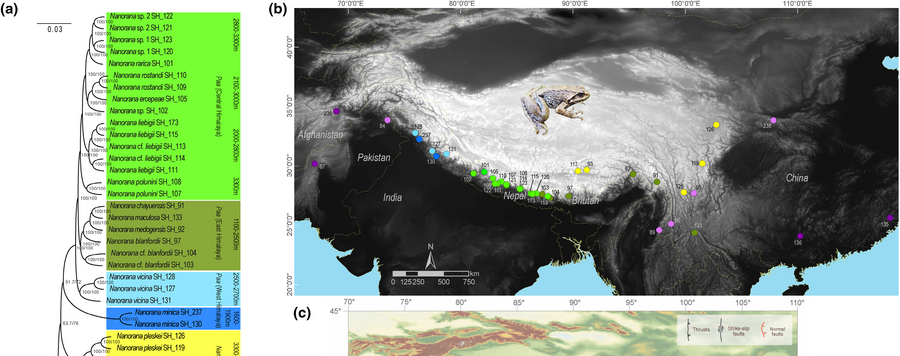
Exploring paleogene Tibet’s warm temperate environments through target enrichment and phylogenetic niche modeling of Himalayan Spiny Frogs (Paini, Dicroglossidae)
The Cenozoic topographic development of the Himalaya-Tibet orogen (HTO) substantially affected the paleoenvironment and biodiversity patterns of High Asia. However, concepts on the evolution and paleoenvironmental history of the HTO differ massively in timing, elevational increase and sequence of surface uplift of the different elements of the orogen. Using target enrichment of a large set of transcriptome-derived markers, ancestral range estimation and paleoclimatic niche modelling, we assess a recently proposed concept of a warm temperate paleo-Tibet in Asian spiny frogs of the tribe Paini band reconstruct their historical biogeography. That concept was previously developed in invertebrates. Because of their early evolutionary origin, low dispersal capacity, high
degree of local endemism, and strict dependence on temperature and humidity, the cladogenesis of spiny frogs may echo the evolution of the HTO paleoenvironment. We show that diversification of main lineages occurred during the early to Mid-Miocene, while the evolution of alpine taxa started during the late Miocene/early Pliocene. Our distribution and niche modelling results indicate range shifts and niche stability that may explain the modern disjunct distributions of spiny frogs. They probably maintained their (sub)tropical or (warm)temperate preferences and moved out of the ancestral paleo-Tibetan area into the Himalaya as the climate shifted, as opposed to adapting
in situ. Based on ancestral range estimation, we assume the existence of low-elevation, climatically suitable corridors across paleo-Tibet during the Miocene along the Kunlun, Qiangtang and/or Gangdese Shan. Our results contribute to a deeper understanding of the mechanisms and processes of faunal evolution in the HTO.






